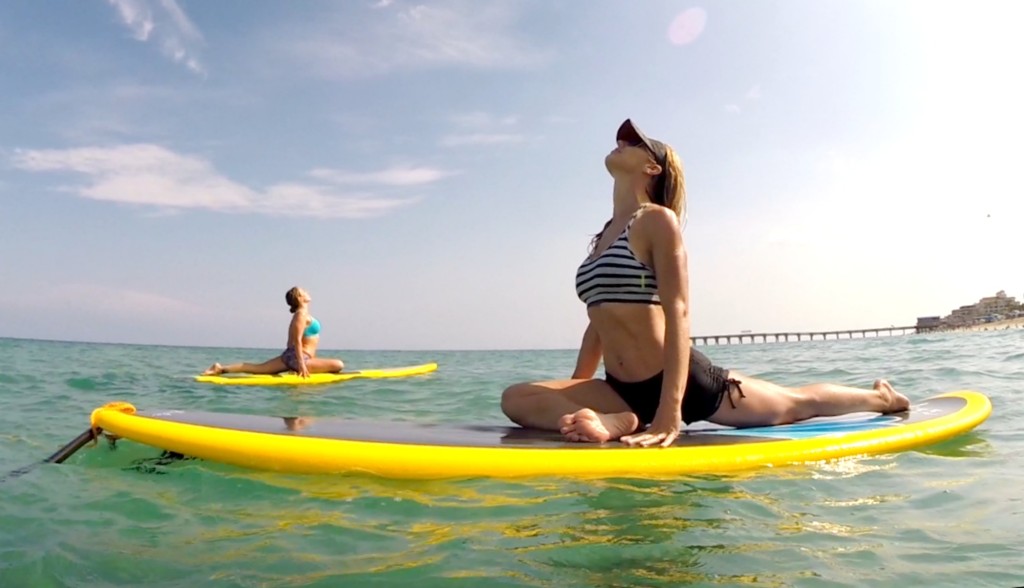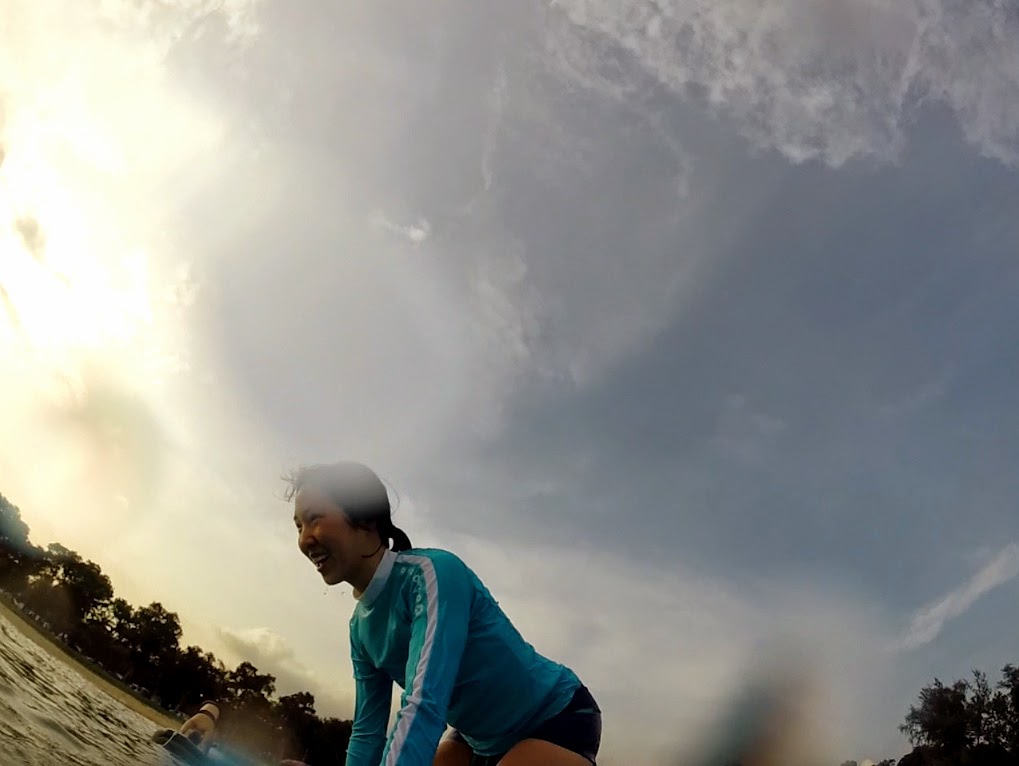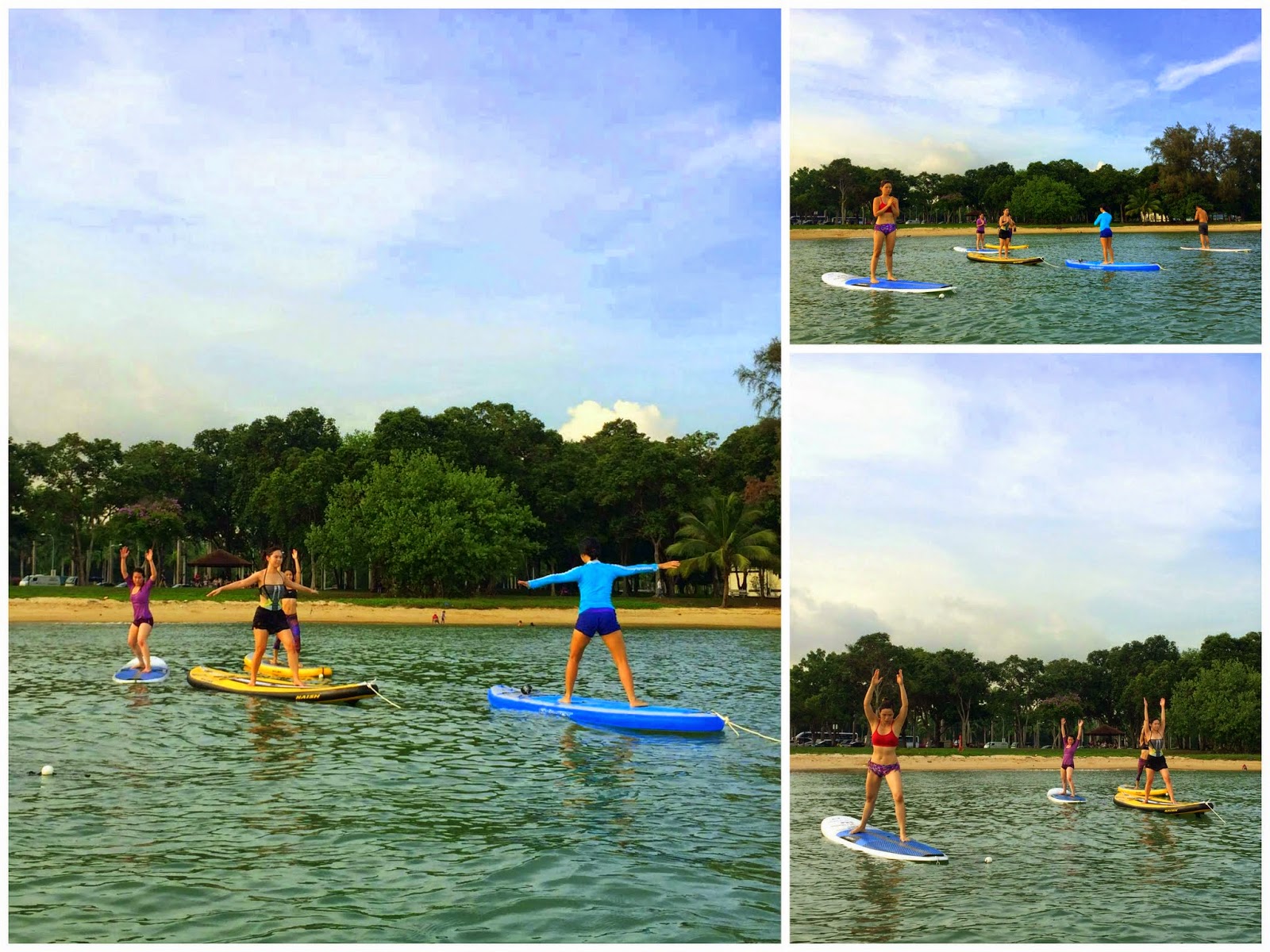To celebrate Earth Day, the wonderful NParks and Sungei Buloh organised a morning’s worth of fun activities, designed to allow visitors to
appreciate the beauty of the mangrove forest, and understand its role in the natural heritage of Singapore.
The first guided tour was to set off at 0930,
which was far too early for my friends and I.
As with most of our peers, we love Saturdays with late starts, as a
panacea to all those early days we have during the week. Thankfully, the kind people at Sungei Buloh
pre-empted this and had later tours, at 1100 and 1300 respectively. The 1100 tour was more of our kind of timing,
though I was a little sad at the thought that we’d miss the plant-a-propagule
segment.
Wait, plant-a-what? A propagule is a propagated mangrove
sapling. To the unscientific eye, they
look very much like long beans haha. These
saplings fall to the mudflat, to allow the tree to propagate itself. The waves might then carry it away so the new
plant doesn’t crowd out its parent. In
Sungei Buloh, to ensure an even spread of plants, park rangers collect fallen
propagules, allow them to grow stronger in a nursery and only then replant them
in the mangrove in selected spots.
As luck would have it, when we arrived, there
were still propagules! All we had to do
was to fill up some little bags with earth and pop a propagule in them, for
them to be sent to the nursery. Volunteers
are also welcome for the eventual transplanting to the mudflats, which will
give you more of the “real deal” feeling of planting, though this may be for
the gutsier types, as our guide told us that you will need a sturdy pair of
boots for this. The mud flats are
squishy and will swallow up boots which are not tightly affixed to your foot
(of course you can still use your hands to dig the boot out).
After the planting, we were ready to go on the
guided tour, starting at the boardwalk.
My friends and I suffer from this peculiar “check-listing” disease. Symptoms include: irrational devising of
checklists in all situations; anxiety/ feelings of being kan cheong when an item cannot be checked-off; and charging ahead
when an item appears. Our checklist for the
day was: crocodiles, horseshoe crabs, smooth otters, and snakes. How could we think we could compel nature to
produce these for our viewing pleasure? (See “irrational”, above.)
The first thing we saw, when our eyes adjusted to
the green, was mosquitoes. Swarms of
mosquitoes. Top tip: bring repellent. Lots of repellent. Or, you can bring a friend who can be the sacrificial
lamb for the group by being the only person who gets bitten (there is usually
one person in every group, and v sadly, when I am around, this person is
me). I wore neutral-coloured clothes,
sprayed repellent liberally, and wore a mosquito patch, but nothing
worked. Despite the pests, it was still
fun and I’d definitely go again, which I think is a pretty good testimony haha.
Back to the tour.
My aural memory (is this even a term?) is pretty good, so I can remember
maybe a good 80% of the guided tour, but I don’t want to give too many spoilers
here, so I will only write down what I considered personally to be highlights.
Sungei Buloh, when translated literally from
Malay into English, is River (Sungei)
Bamboo (Buloh). Bamboo, however, are not native to Singapore. Nonetheless, as you walk along the boardwalk,
you’ll see two groups of bamboo, one at the start and one at the end. The one at the start is dark in colour, almost
black, thin and shaped like a fan. I
initially thought it looked pretty oppressive, till I saw the squirrels playing
and jumping from its branches. Turns out
that squirrels love that bamboo. The one
at the end is what we’re more used to seeing, green straight stalks.
I really liked the sea holly, so named for its
resemblance to the holly that we associate with Christmas. Sea holly has spiky outer leaves, an
adaptation designed to prevent its round inner leaves from being eaten. The plant is really quite pretty, sadly it is
listed as ‘vulnerable’ on the Red List of threatened plants in Singapore (for
more information on this plant, see this website – their AMAZING blog and is my guide to all nature happenings in Singapore).
One thing that struck me was how many plants we
saw have common names which are derived from land plants e.g. sea hibiscus (so
named for the similarity of its flowers), and sea almond (for similarity of the
taste of its seeds!). I guess humans have
a tendency to associate the unfamiliar with the familiar, and it’s always a really
nice feeling, especially when you’re overseas, to see something new and different
which is somehow familiar to something you know from home.
We saw plenty of little tree-climbing/ vinegar crabs as well. Tree-climbing, because the crabs use their sharp legs to scale trees when the tide rises, probably to avoid the predators in the water. Sadly for the crabs, once they are out of the water, they are exposed from the air, and become tasty snacks for the birds. These crabs were also once tasty dishes popular with humans. Our guide's grandfather told her that he used to pickle this crab in black sauce with vinegar, and take it
with porridge (hence the name vinegar crab). He might have been Teochew, as this practice was popular with the Teochews, see here for more info.
Another common creature that is relatively easy to spot (when its basking in the sun) is the mudskipper. As a life-long city dweller, my eyes have become unaccustomed to spotting wildlife, I think I used to be better at this when I was a child! The little boy who was in our tour group was excellent at spotting wildlife, and at his call, my friends and I would eagerly respond with 'Where? Where?' Which eventually became 'WHERE??' when we realised how rubbish our eyes were haha. But with patience and stillness, see the animals you will. Pictured below is the giant mudskipper, which I used to think was very cute until I saw this. Looks like my city eyes gave me false impressions. The giant mudskipper, unlike the yellow-spotted mudskipper, has two black stripes, one down its left and one down its right. It is also, well, giant, or at least larger than the other type. On land, the mudskippers look quite chubby-cheeked, as they store water in pouches to allow them to take in the dissolved oxygen. Fascinatingly, their eyes can roll 360 degrees to access this oxygen!
One thing that was alarmingly easy to spot was litter. This was quite disheartening - who litters in a nature reserve?
The vinegar crab is pictured with edible snails known locally as gong-gong (dog conch).
As a Singaporean, food is never too far from my thoughts.
Another common creature that is relatively easy to spot (when its basking in the sun) is the mudskipper. As a life-long city dweller, my eyes have become unaccustomed to spotting wildlife, I think I used to be better at this when I was a child! The little boy who was in our tour group was excellent at spotting wildlife, and at his call, my friends and I would eagerly respond with 'Where? Where?' Which eventually became 'WHERE??' when we realised how rubbish our eyes were haha. But with patience and stillness, see the animals you will. Pictured below is the giant mudskipper, which I used to think was very cute until I saw this. Looks like my city eyes gave me false impressions. The giant mudskipper, unlike the yellow-spotted mudskipper, has two black stripes, one down its left and one down its right. It is also, well, giant, or at least larger than the other type. On land, the mudskippers look quite chubby-cheeked, as they store water in pouches to allow them to take in the dissolved oxygen. Fascinatingly, their eyes can roll 360 degrees to access this oxygen!
One thing that was alarmingly easy to spot was litter. This was quite disheartening - who litters in a nature reserve?
Not all the litter was as picturesque as this football, there was the usual
plastic bag/ bottle type of litter.
A difficult spot (not by me, obvs) was a weaver bird's nest. This is the great benefit of going in a group: more eyes, all the better to see nature with! This nest was under a tree, and we initially thought it was uninhabited. Nature however, requires some patience, and after a while, the little weaver bird flew home! It carried some twigs in its beak, and proceeded to spruce up its nest, before cosying in till its next flight out.
Busy at work.
Taking a short breather to cosy up in its nest. In less than a minute, it was off again!
I was pretty amazed by another tour guide who spotted a snake. In the picture below, the red of the snake can be seen, but the tree was a slight distance away from the boardwalk, so I think she must have super eyes. This little snake is the paradise tree snake, a gifted glider which can propel itself off trees to spring surprise attacks on its prey. Although as thin as a whip here, it can grow up to 1 metre long, and when it does, it can go after squirrels.
This incredible NatGeo clip, filmed in Singapore, shows the snake in flight. http://www.youtube.com/watch?v=6OVMebCUubs





















































